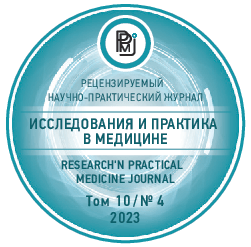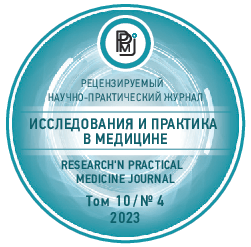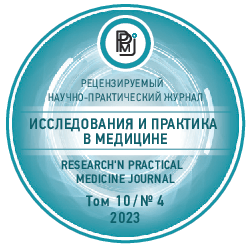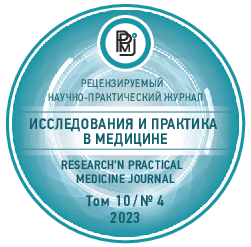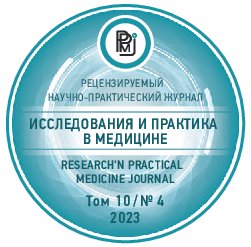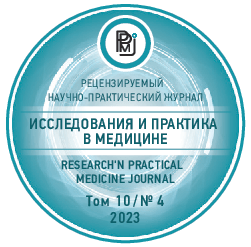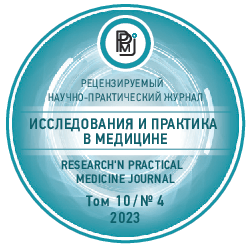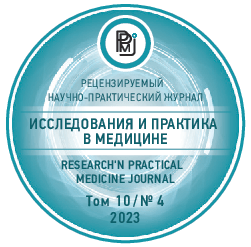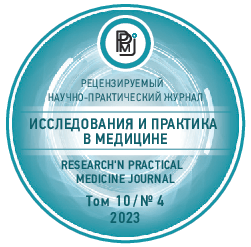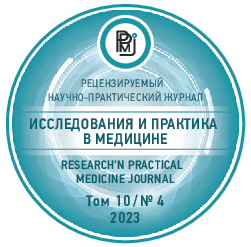Original Articles. Оncology
Purpose of the study. To carry out a comparative analysis of lipid peroxidation intensity and antioxidant system indices in blood neutrophils of patients with primary and relapsed soft tissue sarcomas (STS) depending on sex and age.
Patients and methods. Of the 81 patients included in the study, 48 had primary STS, 5 patients with continued growth, and 28 patients with recurrent STS. The patients were divided by sex and age; the level of lipid peroxidation products, superoxide dismutase (SOD) activity, total peroxidase activity (TPA), glutathione peroxidase (GPx) activity and reduced glutathione (RG) content in blood neutrophils were investigated by conventional spectrophotometric methods. The comparison groups (donors) consisted of 12 men and 17 women divided into the same age subgroups: ≤ 45 years and > 45 years.
Results. In donors, there was a multiple decrease in the SOD/TPA ratio with age, especially in women, and in men this was accompanied by an age-related decrease in GPx activity. In primary sarcomas in older women and in men with continued growth and recurrence, there was an increase in diene conjugates (DC). In men over 45 years of age, there was an increase in SOD, TPA, and GPx. Women of the older age group were characterized by activation of SOD and GPx, expressed in the relapsed process to a significantly greater extent than in men, and an increase in RG was observed in women. The increase in both components of the glutathione system and SOD activity was especially significant in the development of relapses in women for periods exceeding three years, which was accompanied by a decrease in DC content.
Conclusions. Neutrophils are characterized by an increase in DC content in patients of both sexes in the older age group with primary and recurrent STS, with its highest content in men with continued growth and relapses. GPx activity, increased in both men and women in the older age group in all variants of STS development, may play an important role in the antioxidant protection of blood cells in STS. Thus, the most pronounced activation of GPx, accompanied by a maximum increase in reduced glutathione and activation of SOD, contributes to a decrease in the level of DC and the absence of MDA increase in women with slow development of recurrences.
Purpose of the study. Studying the relative copy number of 12 genes: MYC, PTEN, CCND1, PIK3CA, TP53, CDKN2A, MDM2, MCL1, NFKBIA, MTAP, BIRC2, KMT2C, to search for potential prognostic cancer markers in vulvar cancer (VR).
Patients and methods. The study included 50 patients aged 29–80 years with the diagnosis of squamous cell carcinoma of the vulva without metastases – group 1 (n = 25) and with metastases to the lymph nodes – group 2 (n = 25). Total DNA from paraffin blocks of tumor and conditionally healthy vulvar tissue served as the material for the study. The relative copy number of genes (RCQ) was assessed using the RT-qPCR method: MYC, PTEN, CCND1, PIK3CA, TP53, CDKN2A, MDM2, MCL1, NFKBIA, MTAP, BIRC2, KMT2C and reference genes: GAPDH and B2M. Raw RT-qPCR data were analyzed using Bio-Rad CFX Manager software (ver. 2.1). RCQ of the genetic locus was calculated using the formula 2-ΔCt. Analysis of the significance of differences included determination of the OR (CI 95 %), Chi-square, Mann-Whitney U-test. Differences were considered statistically significant at p < 0.05.
Results. Amplification was observed for 9 genes: MYC (48 % of cases), MCL1 (39 %), NFKBIA (46 %), CCND1 (52 %), PIK3CA (48 %), TP53 (62 %), MDM2 (40 %), BIRC2 (54 %), KMT2C (42 %); losses were recorded for 3 genes PTEN (44 % of cases), MTAP (32 %), CDKN2A (36 %). In the 2nd group of patients, a statistically significant 1.7-fold increase in RCQ of the CCND1 gene (p < 0.05) and a 1.9-fold decrease in RCQ of the PTEN gene (p < 0.05) were found.
Conclusion. In the study, CCND1 amplification events and/or PTEN loss were associated with lymph node metastasis in RV patients. Thus, the copy numbers of these genes may serve as prognostic markers of the disease.
Purpose of the study. To isolate and verify pure fractions of secondary plant metabolites contained in B. vulgaris (L.) and P. hibridus (L.), as well as to conduct a model experiment and molecular genetic study to evaluate their cytotoxic effect in vitro on the HeLa cell line.
Materials and methods. The isolation and verification of all compounds used in the experiment were carried out using column chromatography and nuclear magnetic resonance methods at the Department of Natural Compounds, Faculty of Chemistry, Southern Federal University. Subsequently, an experiment was conducted using cultural and molecular methods on the HeLa cell line in three repetitions for each test compound; after incubation with them, the numbers of dead cells were counted on the automated NanoEnTek JuliFl counter, and the numbers of cells in apoptosis were measured by flow cytometry on the BD analyzer FACS Canto II. The level of copy number variation and expression of genes responsible for apoptosis were assessed by real-time PCR (RT-PCR). In total, three substances were studied, with two concentrations (4 and 12 μg/ml) and two exposures (24 and 72 hours) for each of them.
Results. In the first stage of the study, we isolated and verified the berberine alkaloid extracted from the roots of B. vulgaris (L.), as well as 2,4-dihydroxy-2,5-dimethylfuran-3(2H)-one and 2,2,8-trimethyldecahydroazulene-5,6-dicarbaldehyde from P. hibridus (L.). The subsequent stage of the study demonstrated the maximal cellular death under the action of berberine at a 72-hour exposure. However, the RT-PCR assessment of the copy number variation and expression of the CASP8, CASP9, CASP3, BAX, BCL2, TP53 and MDM2 genes revealed the presence of apoptosis initiation in tumor cells at the molecular level under the action of all the studied compounds: both berberine and furan and azulene derivatives derived from P. hibridus (L.).
Conclusion. All compounds used in the experiment exhibited a cytotoxic effect on the HeLa cell line. Berberine alkaloid showed the most pronounced cytotoxic effect on the HeLa line as recorded by all methods used in the study. Terpenoids 4-dihydroxy-2,5-dimethylfuran-3(2H)-one and 2,2,8-trimethyldecahydroazulene-5,6-dicarbaldehyde, when exposed to the HeLa line, caused an increase in the copy number variation and expression of the CASP9, CASP3 loci, which are among the main activators of apoptosis. They also influenced the expression of TP53 and MDM2 loci.
Purpose of the study. Сomparing and evaluating the prognostic potential of the CORONET online risk assessment tool and the Charlson Comorbidity Index in predicting mortality in cancer patients with COVID-19.
Materials and methods. The results are drawn from the data of 168 case histories of cancer patients who were undergoing inpatient treatment for COVID-19 at the University Clinical Hospitals of Sechenov University between March 2020 and February 2022. The study was conducted as part of the program of the world-class research center “Digital Biodesign and Personalized Healthcare” of Sechenov University, with participation in the ESMO-CoCARE Registry project. Patients with a history of solid or hematologic malignancies were included in the study; their treatment period before the study was 5 years or less. The age ranged from 37 to 100 years, the median age was 69 years. The CORONET online risk assessment tool and the Charlson comorbidity index were used to objectify the severity of multimorbidity status and prognosis of fatal outcomes in cancer patients with COVID-19.
Results. It was demonstrated that statistically significant effects on the prognosis of mortality in patients with cancer were: age, percentage of saturation on admission, treatment in intensive care units (ICU), National Early Warning Score 2 (NEWS2) distress syndrome severity scale score, computed tomography (CT) assessment of disease course severity, decreased blood albumin and platelet counts, and increased blood neutrophil counts in both categorical and immediate indicator value formats. In addition, it was determined that as the number of comorbidities increased, the probability of mortality increased significantly, odds ratio (OR) = 2.162 (CI 95 % 1.016–4.600; p = 0.045). The CORONET calculator score yields one of the highest OR values among all established statistically significant predictors, 20.410 (CI 95 % 4.894–85.113; p < 0.001). For oncopathology in COVID-19 patients, the Charlson index score shows statistical significance as a predictor of mortality, OR =1.396 (CI 9 5 % 1.105–1.765; p = 0.005).
Conclusion. The obtained advantages in using the CORONET online decision support tool over the Charlson comorbidity index in predicting mortality in cancer patients with COVID-19 are recognized as convincing.
Purpose of the study. Obtaining lung cancer tumors in Balb/c Nude mice by transplantation of mitochondria isolated from human malignant tumors.
Materials and methods. Human lung cancer mitochondria were isolated using differential centrifugation on a high-speed refrigerated centrifuge. Mitochondrial samples were diluted with 0.9 % NaCl solution to a protein concentration of 3 mg per animal. Freshly isolated lung cancer mitochondria were once transplanted into the tail vein of male Balb/c Nude mice (n = 6) at the rate of 3 mg of protein per 1 animal in 0.4 ml of saline. Male mice of Balb/c Nude line (n = 4), which were injected with 0.4 ml of physiological solution into the tail vein once a day, served as a control group. All animals were killed by guillotine decapitation 4 months after intravenous transplantation of mitochondria isolated from lung cancer.
Results. After the introduction of mitochondria into the tail vein of mice, no changes were found in the animals’ behavior, coloration of coverings. No respiratory problems, and no allergic reactions to the introduction of foreign protein were detected. Respiratory problems in mice with mitochondrial transplantation occurred between days 113 and 123, when a drop in body weight ≥ 25 % was observed. A uniform formation of tumor nodes together with an active filling of the lung space with blood was clearly visible on lung preparations of a Balb/c Nude male mouse after intravenous transplantation of mitochondria from the lung of a patient with non-keratinizing squamous cell carcinoma. Similar characteristics of tumor growth in the lung parenchyma of the patient and Balb/c Nude mice as direct recipients of tumor mitochondria involved solid structures consisting of fields, cells and strands of tightly fitting atypical polymorphic cells of the squamous epithelium with poorly developed cytoplasm. In addition, signs of adenocarcinoma included glandular and papillary-like structures and cell complexes with large nucleoli. Squamous epithelial cells were characterized by severe atypia and polymorphism. The shape of the nuclei was irregular in most cells, with large sizes, the color was heterogeneous, and the nucleoli were enlarged. Multinucleated cells, as well as pathological mitoses with clearly marked division figures, which testified to their proliferative activity, were encountered with a rather high frequency.
Conclusions. Application of intravenous transplantation of mitochondria isolated from malignant human lung tumor in male mice of Balb/c Nude line causes growth and development of malignant foci in male Balb/c Nude mice. This is previously unknown fact in experimental oncology, allowing the study of new properties of mitochondria of human cancer cells.
Original Articles. Surgery
Purpose of the study. Evaluation of the safety and effectiveness of single-port thoracoscopic thymectomy in comparison with traditional three-port thymectomy in patients with stage I and II thymic epithelial tumors.
Patients and methods. The results of 50 thoracoscopic thymectomies performed from January 2019 to May 2023 on patients with stage I and II thymic epithelial tumors without the presence of myasthenia were analyzed. The age of the patients ranged from 20 to 75 years, with a median of 44 years. There were 28 (56 %) women, 22 (44 %) men. The minimum size of the removed thymoma in the study was 20 mm, the maximum was 165 mm. Out of the 50 patients who underwent singleand three-port thoracoscopic thymectomy, 42 (84 %) had tumor diameters of 70 mm or less, and 8 (16 %) had tumor diameters greater than 70 mm. Tumor size was significantly larger in the three-port thymectomy group (43 mm [35 mm; 55 mm] vs. 60 mm [38 mm; 78 mm], p = 0.044).
Results. The analysis noted a statistically significant increase in the duration of the operation in the group of three-port thoracoscopic thymectomies (duration of operations – 107.5 minutes [70 minutes; 132.5 minutes] versus 70.0 minutes [57 minutes; 79 minutes] in the group with a single-port approach). A statically significant result was also obtained in terms of drainage of pleural cavity drainage and, as a consequence, in duration of postoperative bed rest. Patients operated through a single-port approach stayed in the hospital for 3 to 5 days on average (4.0 days), while those with a three-port approach stayed from 3 to 13 days on average (5.0 days). A comparative analysis revealed a significant reduction in the length of hospital stay in patients who underwent single-port thoracoscopic thymectomy, in contrast to those undergoing three-port surgical interventions.
Conclusion. This study is the first in Russia to compare oneand three-port techniques for removing thymic tumors in a number of patients sufficient for statistical calculations. It has been shown that for thymic tumors up to 5 cm, single-port thoracoscopic thymectomy compared to three-port does not lead to prolongation of the operation or an increase in intraand postoperative complications. Therefore, in our opinion, it is the preferable option.
Original Articles. Urology
Purpose of the study. To evaluate the levels of metabolic markers in patients with prostate cancer (PCa) in comparison with patients with benign prostatic hyperplasia (BPH).
Patients and methods. 108 patients were included in the study. The majority of patients had comorbidities: coronary heart disease, hypertension, and almost one third of patients had type 2 diabetes mellitus. Median (Me) age was 67 (64–74), body mass index was 25.9–34.7. The main study group included 54 patients with histologically verified prostate cancer, the comparison group consisted of 54 patients with benign prostatic hyperplasia (BPH). The level of basic biochemical parameters, glomerular filtration rate, lipidogram, total prostate-specific antigen (PSA), total testosterone was determined in all patients.
Results. When comparing anamnestic and biochemical parameters, the groups were not statistically significantly different. When comparing the groups by lipid status, it turned out that in the group with RPW, in contrast to the group of patients with BHP, statistically significantly higher levels of total cholesterol (5.13 (3.3–10,4) and 4.60 (2.5–6.3)) mmol/L, respectively, p = 0.023), low–density lipoproteins (2.93 (0.8–5.9) and 2.60 (0.9–4.2) mmol/L, respectively, p = 0.035), triglycerides (2.10 (1.0–8.0) and 1.70 (0.5–7.3) mmol/L, respectively, p = 0.048). In case of dyslipidemia, an increased risk of developing PCa was identified. Correlation analysis revealed a direct moderate relationship between total PSA levels and total cholesterol concentration (r = 0.51).
Conclusion. Our study revealed that in the PCa group, there was a higher level of total cholesterol, low-density lipoproteins, and triglycerides, in contrast to the group of patients with BPH. Additionally, in the group of patients with BPH, dyslipidemia was a risk factor in the development of PCa, which should be taken into account in PCa prevention and diagnosis.
Clinical and Laboratory Observations
Purpose of the study. Evaluation of the diagnostic value of vacuum-assisted biopsy (VAB) based on pathomorphological studies in patients with breast cancer (BC) who have achieved a complete clinical response (cCR) after neoadjuvant polychemotherapy (NACT).
Patients and methods. In the study, conducted from 2021 to 2023 at the P. A. Hertsen Moscow Oncology Research Institute – a branch of the National Medical Research Radiology Center of the Ministry of Health of Russia, 35 patients with BC cT1–3N0–3M0 of various molecular-biological types who were diagnosed with cCR after NACT were included. All patients underwent VAB (needle size 7–10 G) of the breast followed by histological examination, after which surgical treatment was performed. Subsequently, histological conclusions of VAB and surgical materials were compared with each other for the presence and degree of pathomorphological response.
Results. According to the pathomorphological conclusion when conducting VAB, the following results were obtained: 1 – true positive, 29 – true negative, 3 – false negative, and 0 – false positive. No statistically significant results of the association between complete pathomorphological response and the molecular-biological type of breast cancer were obtained (p > 0.05), however, there is a tendency towards the greatest number of complete pathomorphological responses in Her2-neu-positive (luminal – 100 %, non-luminal – 90.9 %) and triple-negative (87.50 %) types of breast cancer. The overall sensitivity of the method was 25.0 % (CI 6.8–60.2 %); specificity – 100 % (CI 88.1–100 %); false-negative result (presence of tumor cells in the surgical material and a negative result of VAB) – 9.1 % (CI 3.4–20.2 %); false-positive result (absence of tumor cells in the surgical material and a positive result of VAB) – 0 % (CI 0–10.6 %). The overall diagnostic accuracy of the method was 90.9 % (CI 79.8–96.6 %).
Conclusion. The results of the conducted research allow for the consideration of excluding surgical treatment when a complete pathomorphological response is obtained by VAB. However, further research is required with the inclusion of a larger number of patients.
Review
Purpose of the study. Analysis of contemporary literature sources dedicated to the study of characteristics of high oncogenic risk human papillomavirus (HPV), associative links of the virus’s molecular-genetic parameters with the clinical and morphological characteristics of invasive cervical cancer (ICC).
Materials and methods. A literature search was conducted in electronic databases including the National Center for Biotechnology Information Search database (PubMed/Medline), ResearchGate, Scopus, Web of Science, Cancer Tomorrow, Global cancer observatory, Cochrane Library, eLIBRARY, DisserCat. The search covered the period from 1990 to 2022 and utilized keywords in Russian and their English translations: cervical cancer, high oncogenic risk HPV, HPV status, HPV genotype, multiple infections, DNA integration, viral load. More than 120 full-text sources were studied, in which the analysis of possible correlations between the parameters of human papillomavirus infection and the clinical and morphological characteristics of cervical cancer was carried out. In review included data from 57 publications.
Results. According to most authors, more than 88 % of patients with invasive ICC are HPV-infected. The etiological structure is dominated by HPV 16 (70–72 %), 18 (13–15 %), and 45 (5–7 %) types. Non-detection of HPV HR in cervical cancer is associated, including with a false negative result of the study.
The literature analysis showed the presence of an association between HPV status and age, morphological form of the tumor, viral load, high oncogenic risk HPV genotype, presence of deep stromal invasion, and metastatic involvement of lymph nodes. With regard to such molecular genetic parameters of HPV HR as viral load and HPV DNA integration, associative relationship with prognostic important clinical indicators of cervical tumor – the stage of the disease, the loco-regional prevalence of the tumor process, the histological type of tumor – remains the subject of discussion.
Conclusion. Many publications report a correlative link between HPV status and high oncogenic risk HPV genotype with such an important factor affecting ICC treatment outcomes as the morphological form of the tumor. Ambiguous conclusions on the presence of an association between a number of molecular-genetic parameters of HPV infection with the main prognostic factor – stage of the disease (due to the heterogeneity of samples, the use of different test systems, and the insufficiently complete account of the main parameters of HPV infection, especially data on viral DNA integration), make it advisable to conduct further research on a representative group of patients with homogeneous diagnostic protocols to determine the most complete spectrum of parameters of high oncogenic risk HPV. In addition, the conducted literature analysis showed the promise of searching for predictors of the effectiveness of specialized treatment of patients with ICC among such HPV infection parameters as HPV status, high oncogenic risk HPV genotype, and the significantly associated physical status of viral DNA.
Clinical Case Reports
Currently, strategies for the management of tumor diseases of the urinary tract in combination with cardiovascular pathologies are controversial. In domestic literature, only isolated reports are found concerning the treatment of combined oncological and cardiovascular pathologies, and the global experience is limited to individual clinical observations and small retrospective series, primarily describing the experience of individual centers. The current challenge for specialists is to establish the ideal treatment sequence with regard to the optimal timing of each surgical procedure and the initial priority of treatment, or the possibility of performing them simultaneously. The article presents a case of successful simultaneous surgical intervention for juxtarenal abdominal aortic aneurysm (AAA) and renal cell carcinoma (RCC) of the left kidney. The patient underwent resection of an abdominal aortic aneurysm with the replacement of the left renal artery, resection of the left kidney under pharmaco-cold ischemia, with thrombectomy from the renal vein. The postoperative period proceeded satisfactorily. After 6 months, on the control computed tomography of the abdominal organs with contrast enhancement (CT) of the abdominal cavity with CU, the prosthesis of the abdominal aorta and the left renal artery are functioning. According to color duplex scanning (CDS) of the renal vessels, the blood flow in the left kidney is preserved to the periphery with normal speed indicators. No data on the recurrence of the oncological process were received.



